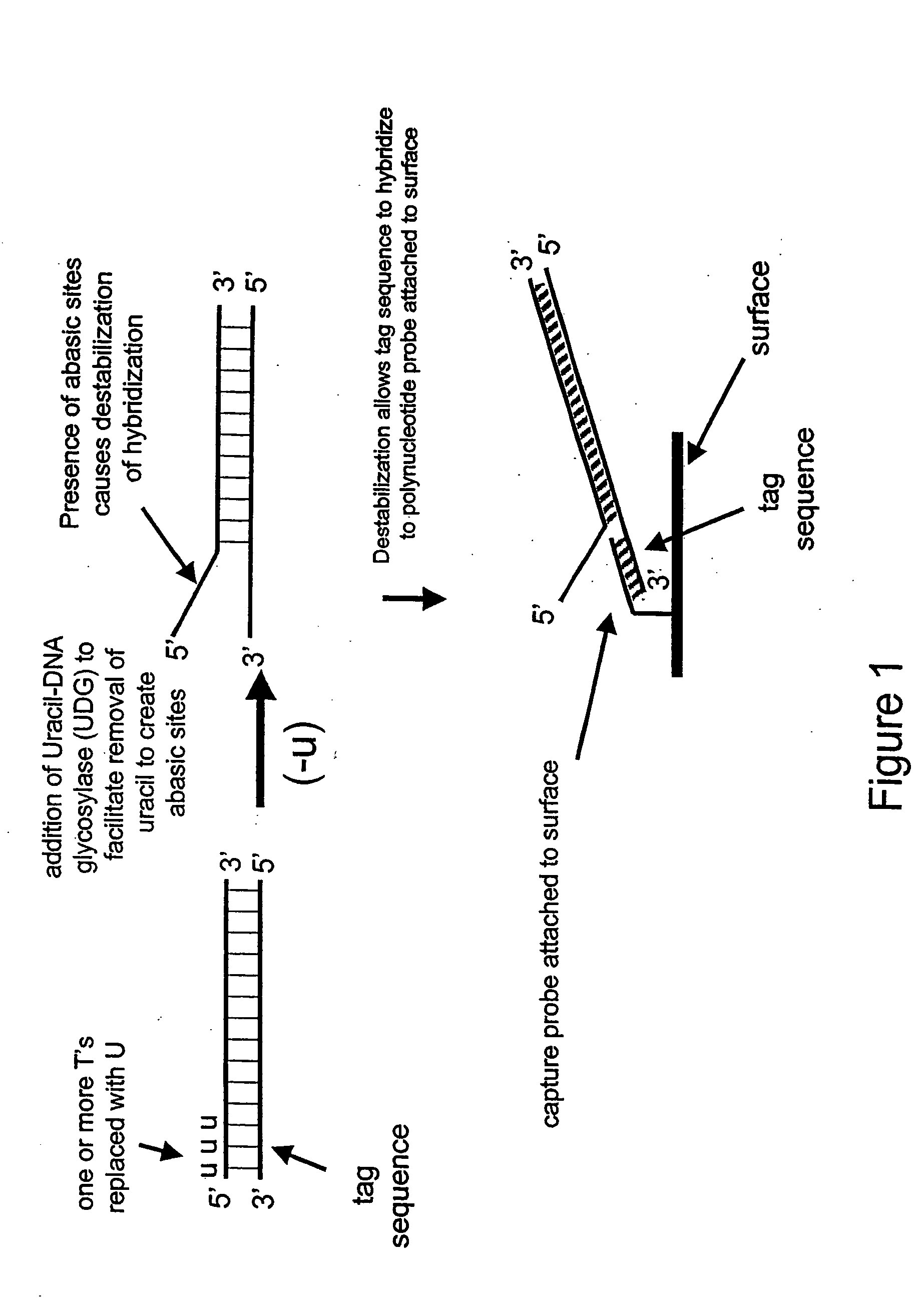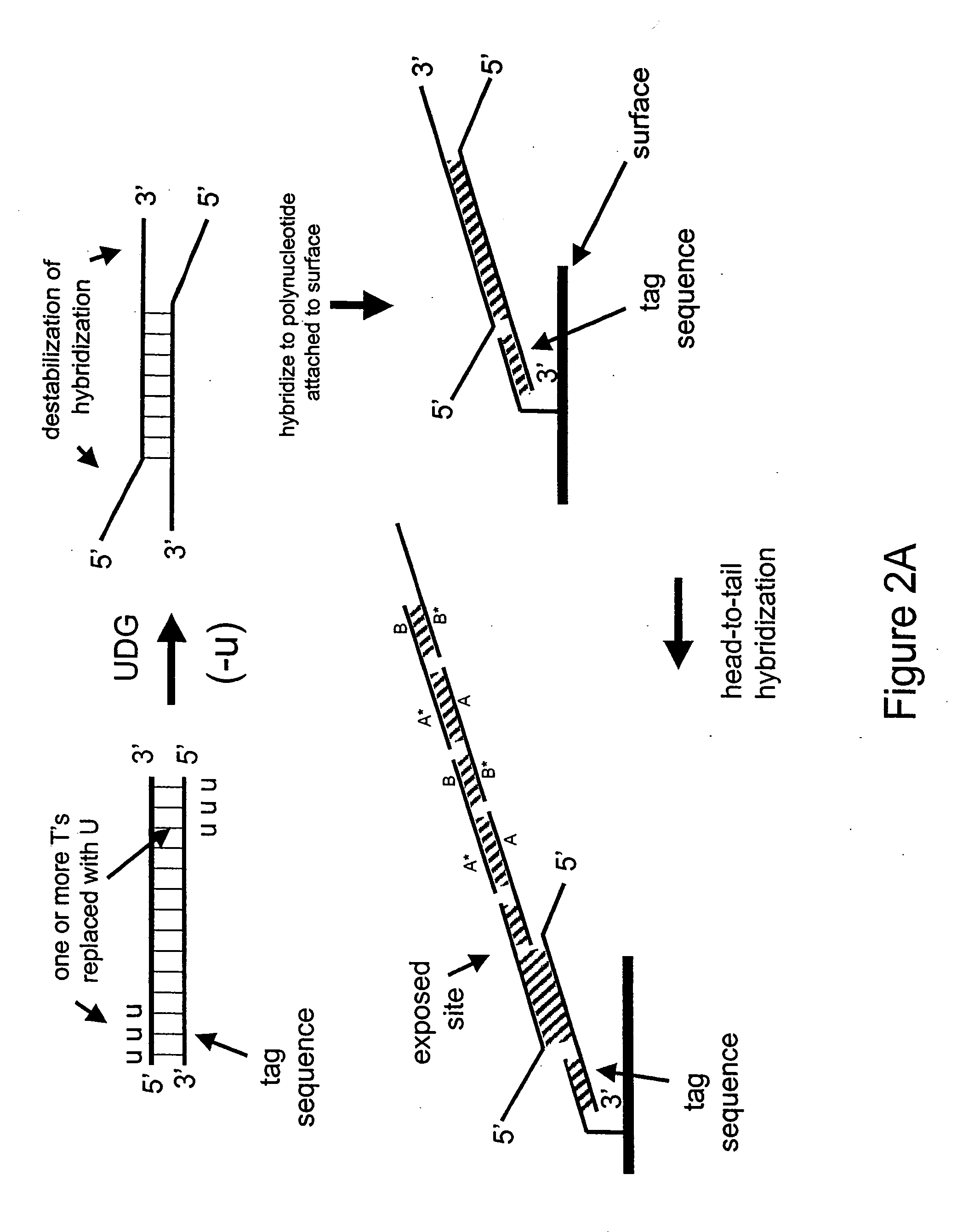Nucleic acid hybridization methods
a technology of nucleic acid and hybridization method, which is applied in the field of nucleic acid hybridization, can solve the problems of large manufacturing investment, limited sample range of chips, and impaired specificity of such an array
- Summary
- Abstract
- Description
- Claims
- Application Information
AI Technical Summary
Problems solved by technology
Method used
Image
Examples
example 1
Synthesis of a Single-Stranded Template having Uracil in Place of Thymine
[0175] In this example, a single-stranded deoxyribonucleic acid is synthesized having uracil in place of thymine.
[0176] A 35 base oligonucleotide is designed such that its 5′ portion (15 bases) comprises the same sequence as a capture probe having the sequence 5′-GTACGGATAACTACG-3′ (SEQ ID NO: 1) except the thymines are replaced with uracils as follows: 5′-GUACGGAUAACUACG-3′ (SEQ ID NO: 2). The remaining 3′ portion of the oligonucleotide (20 bases) is complementary to a portion of human genomic DNA having Coriell accession number NA12444B, incorporated herein by reference in its entirety, and does not comprise uracil. The 40-mer single-stranded DNA is synthesized using standard phosphoramidite chemistry with dU-phosporamidite on an ABI 394 nucleic acid synthesizer.
[0177] In the next example, a double-stranded deoxynucleic acid is synthesized having uracil in place of thymine at the 5′ end of each strand
example 2
Generation of a Double-Stranded DNA having Uracil in Place of Thymine
[0178] In this Example, PCR is used to amplify a double-stranded DNA having uracil in place of thymine at the 5′ ends of each strand.
[0179] A 35 base reverse PCR primer is designed such that its 5′ portion comprises the same sequence as a 15 base portion of the circular RCA probe 75.03 having the sequence 5′-CGTAGTTATCCGTAC-3′ (SEQ ID NO: 3) except the thymines are replaced with uracils as follows: 5′-CGUAGUUAUCCGUAC-3′ (SEQ ID NO: 4). The remaining 3′ portion of the primer (20 bases) is complementary to a portion of human genomic DNA having accession number NA12444B (Coriell) and does not comprise uracil. The 35-mer reverse PCR primer is synthesized using standard phosphoramidite chemistry with dU-phosporamidite on an ABI 394 nucleic acid synthesizer. The forward primer is the uracil-containing 35-mer from Example 1.
[0180] The reverse PCR primer is used together with the forward PCR primer to amplify a portion ...
example 3
Binding and Detection of a Destabilized Double-Stranded Target DNA to a Capture Probe
[0182] This Example demonstrates the destabilization of hybridization in the 5′ regions of the PCR amplification product synthesized in Example 2 and subsequent binding to a capture probe.
[0183] An oligonucleotide comprising the sequence 5′-GTACGGATAACTACG-3′ (SEQ ID NO: 1), to be fixed to the surface of a universal chip for use as a detection probe, is dissolved to a final concentration of 6 μM in a buffer comprising 10 mM HEPS, 50 mM LiCl and 0.4 mg / ml NeutraAvidin at pH 7.4. After 20 minutes the solution is adjusted to contain 12.5% isopropanol and 6 μl of the solution was deposited onto a universal detector chip. The chip is dried at room temperature, coated with Stable coat for 20 minutes, and then dried in a vacuum. To remove any unbound detection probe, the chip is soaked at 37° C. in a solution of 10 mM HEPS, 200 mM LiCl and 0.05% Tween 20 at pH 7.5 for 15 minutes then rinsed twice with a ...
PUM
| Property | Measurement | Unit |
|---|---|---|
| concentration | aaaaa | aaaaa |
| pH | aaaaa | aaaaa |
| pH | aaaaa | aaaaa |
Abstract
Description
Claims
Application Information
 Login to View More
Login to View More - R&D
- Intellectual Property
- Life Sciences
- Materials
- Tech Scout
- Unparalleled Data Quality
- Higher Quality Content
- 60% Fewer Hallucinations
Browse by: Latest US Patents, China's latest patents, Technical Efficacy Thesaurus, Application Domain, Technology Topic, Popular Technical Reports.
© 2025 PatSnap. All rights reserved.Legal|Privacy policy|Modern Slavery Act Transparency Statement|Sitemap|About US| Contact US: help@patsnap.com



